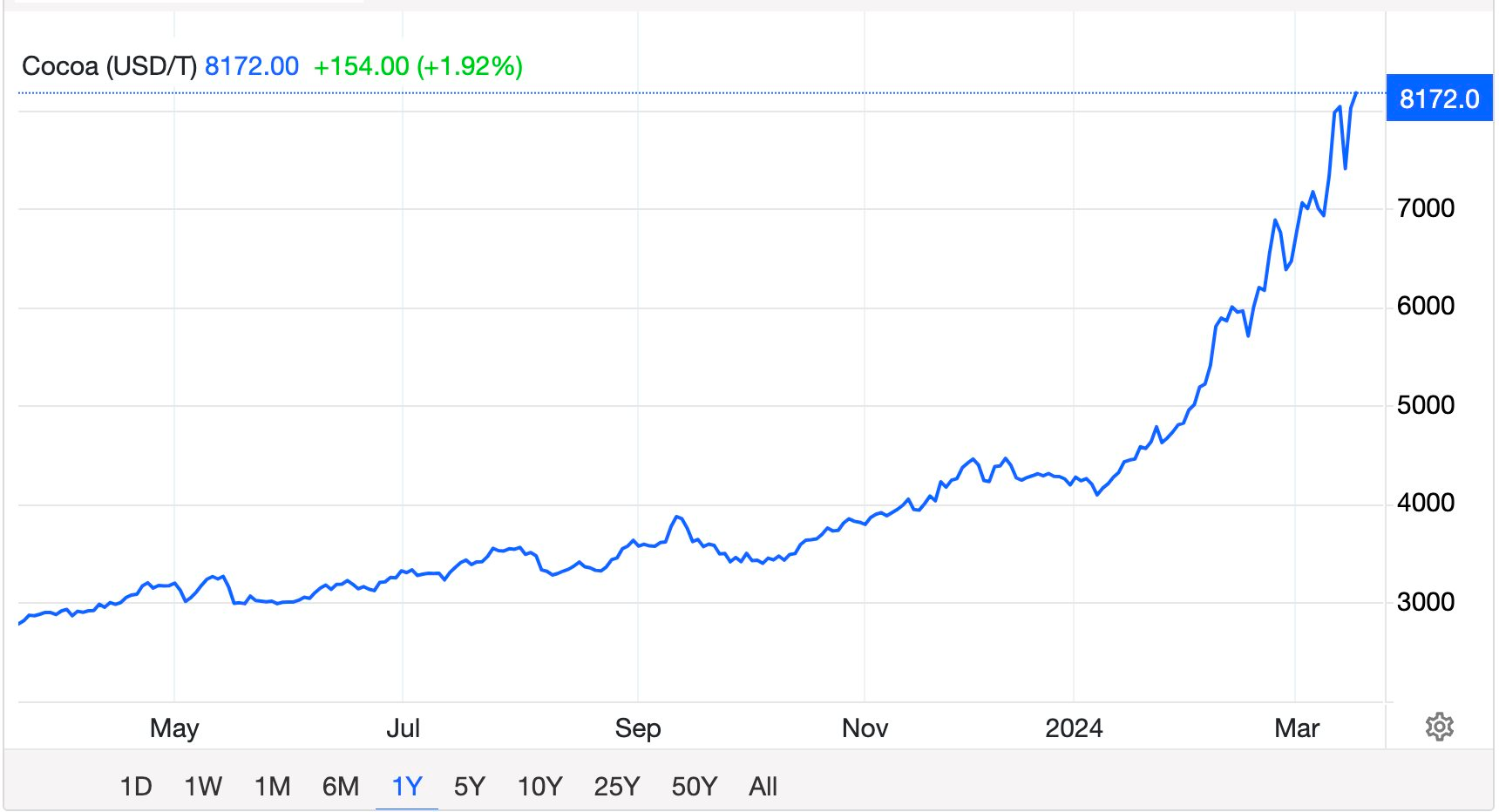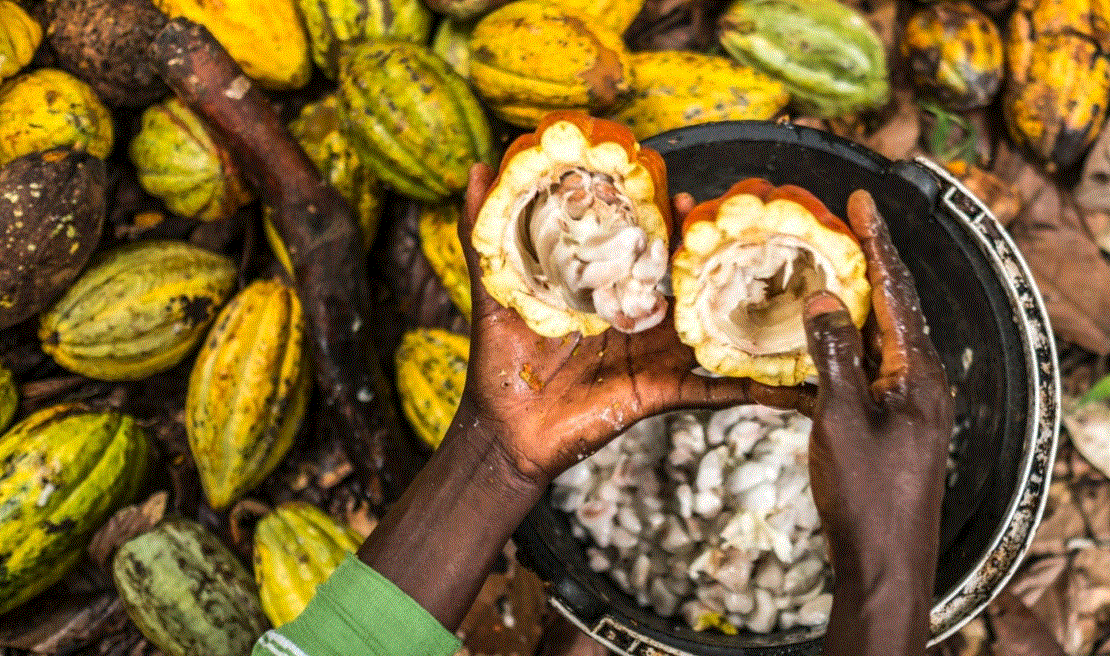
New record high for cocoa prices.
On Monday (18/3), the reference cocoa futures price on the New York market reached a record high of $8,439/ton, the highest level in history.
Within just one week, prices have increased by 25% and are more than 215% higher than the same period last year.
Since the beginning of the year, in less than 3 months, futures cocoa prices have doubled as Easter approaches. The financial difficulties faced by the world’s leading cocoa producers mean they no longer have the ability to buy raw cocoa beans.
In the past, a shortage of supply has pushed cocoa prices up to a high in the 1970s, reaching a peak of $5,379/ton in July 1977, according to data compiled by Bloomberg. In March 2011, the cocoa market once again faced a price crisis when the civil war in Côte d’Ivoire led to a ban on cocoa exports, pushing prices to a record high at that time.
Why are cocoa prices so high?
First, you need to know that cocoa trees only thrive in a narrow band around the equator, which is why the 4 West African countries (Côte d’Ivoire, Ghana, Cameroon, and Nigeria) produce nearly 75% of the world’s cocoa supply, according to commodity expert Javier Blas of Bloomberg Opinion. Reuters notes that Côte d’Ivoire alone produces nearly half of the world’s cocoa supply.
Due to bad weather, diseases on trees, and a lack of investment in new trees for decades, recent cocoa harvests in this region have been very poor, leading to a growing supply-demand imbalance.
The cocoa market is in chaos because the major cocoa-producing countries – Côte d’Ivoire and Ghana – have experienced poor harvests for 3 consecutive years due to diseases affecting the cocoa trees. Currently, the 2 countries are in the midst of the worst harvest season in years, with estimated harvests in Côte d’Ivoire down more than 28% from the previous season.

Africa has lost the cocoa crop for 3 consecutive years.
Some cocoa factories in Côte d’Ivoire and Ghana have stopped or reduced processing because they do not have enough money to buy raw cocoa. Chocolate producers cannot make chocolate from raw cocoa and rely on processors to turn the beans into butter and liquor that can be made into chocolate.
This has led to concerns about the available cocoa supply. Market agents are increasingly worried about prices and whether there will be enough cocoa to meet global demand. According to the International Cocoa Organization, the cocoa market will face a shortage of 374,000 tons this season, an increase from the 74,000-ton shortfall last season. The ICCO forecasts that global cocoa stocks at the end of the 2023/24 season will drop to 1.395 million tons, equivalent to 29.2% of the cocoa grinding volume, the lowest level in 45 years.
Of course, supply is just one side of the price equation: because chocolate has gone from being a luxury item to something you can easily buy before watching a movie, global demand has doubled over the past three decades, noted commodity expert Javier Blas of Bloomberg Opinion.
Meanwhile, the skyrocketing price of cocoa has caused large cocoa processors in Africa – who use raw cocoa to create usable cocoa for chocolate companies – to cut production because they no longer have enough money to buy beans, while manufacturers usually have to buy cocoa beans months in advance.
Will chocolate become more expensive?
The high price of cocoa and low supply is expected to impact various industries, especially the chocolate industry, which requires cocoa as its main ingredient.
In fact, the price of chocolate has already increased. According to market research firm Circana, the price of chocolate products at retail stores in the US increased by 11.6% in 2023 compared to the previous year. In the future, confectionery company Hershey and Cadbury Mondelez warned that they will have no choice but to pass on the higher cocoa costs to consumers.
“The ‘cocoa demonstration’ is beginning to have a major impact, driving up costs for consumers and forcing chocolate manufacturers to seek supply. They only have one of three options: to make smaller chocolate bars, increase prices if they want to keep the same weight, or add other flavors,” said Martin Hug, chief financial officer of chocolate manufacturer Lindt & Spruengli AG.
How will the market outlook be?
The price of cocoa is expected to remain high for a long period of time due to the crops in West Africa – the heavy cocoa-growing region – being affected by diseases and extreme weather events, leading to a third consecutive supply shortage.
Fuad Mohammed Abubakar, CEO of Cacao Marketing Company Ghana UK Ltd, said “there is still no clear information about the next season” starting in autumn. “The challenges for Côte d’Ivoire and Ghana are that no one knows how they can solve their production problems. There will be no source of rescue supply in the months to come.”
Meanwhile, demand is also improving.
Analysts at Citi Research previously said prices could rise to $10,000/ton and remain at a high level until the second half of 2025.
Reference: Morningbrew












